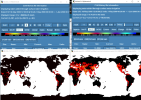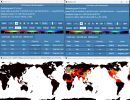I have observed a stark contrast in irrigation coverage (mostly in the northern hemisphere) between cesm2.2.2 and ctsm5.2 CLM runs with identical case setup. Both runs used I2000Clm50BgcCrop compset and were simulated for 12 months starting 2000-01-01. Similar issue in all three irrigation variables (QIRRIG_FROM_GW_CONFINED, QIRRIG_FROM_GW_UNCONFINED, and QIRRIG_FROM_SURFACE). What is causing this difference? Has this behaviour been documented previously?

Is this issue related to my case setup? The case paths and output paths are as follows:
cesm2.2.2 case location: /glade/work/amans/cases/global_cesm2_2_2_I2000Clm50BgcCrop/
ctsm5.2 case location: /glade/work/amans/cases/global_ctsm5_2_I2000Clm50BgcCrop/
cesm2.2.2 output history files: /glade/derecho/scratch/amans/archive/global_cesm2_2_2_I2000Clm50BgcCrop/lnd/hist/
ctsm5.2 output history files: /glade/derecho/scratch/amans/archive/global_ctsm5_2_I2000Clm50BgcCrop/lnd/hist/
This issue is relevant to me because I am running regional Clm51BgcCrop simulations in the midwest US using surfaces subsetted for ctsm5.2. All QIRRIG values are zero for the midwest US simulation from 1980-2020.
Thank you!

Is this issue related to my case setup? The case paths and output paths are as follows:
cesm2.2.2 case location: /glade/work/amans/cases/global_cesm2_2_2_I2000Clm50BgcCrop/
ctsm5.2 case location: /glade/work/amans/cases/global_ctsm5_2_I2000Clm50BgcCrop/
cesm2.2.2 output history files: /glade/derecho/scratch/amans/archive/global_cesm2_2_2_I2000Clm50BgcCrop/lnd/hist/
ctsm5.2 output history files: /glade/derecho/scratch/amans/archive/global_ctsm5_2_I2000Clm50BgcCrop/lnd/hist/
This issue is relevant to me because I am running regional Clm51BgcCrop simulations in the midwest US using surfaces subsetted for ctsm5.2. All QIRRIG values are zero for the midwest US simulation from 1980-2020.
Thank you!


